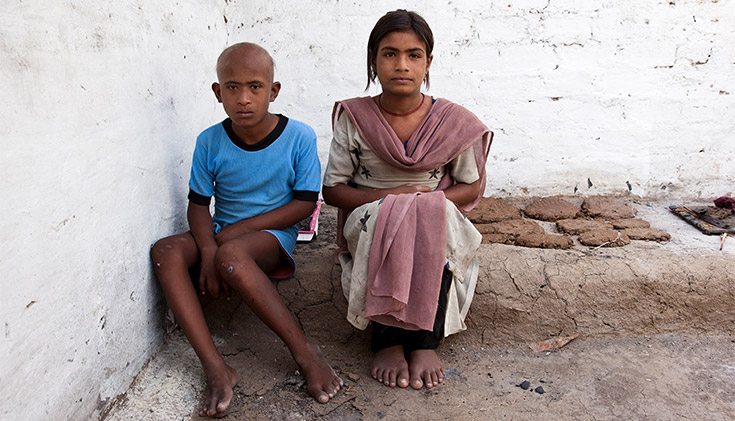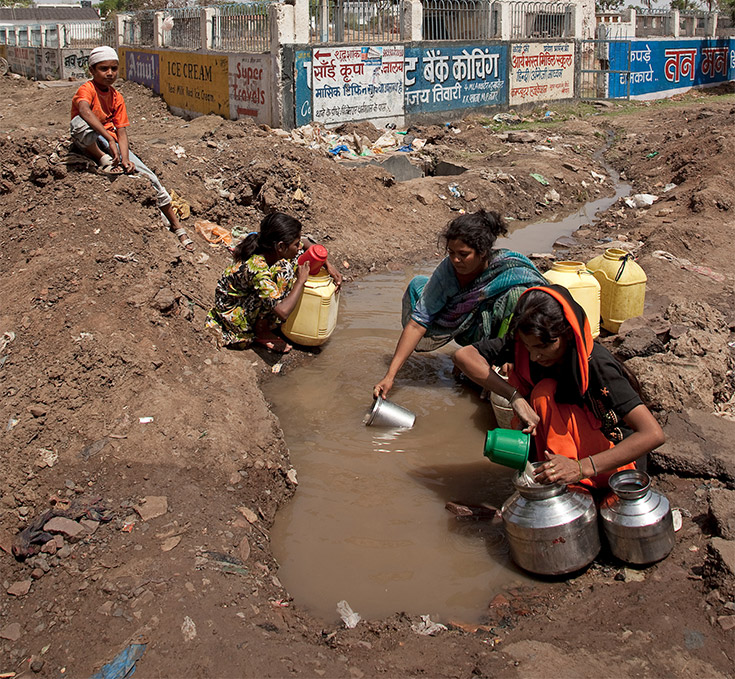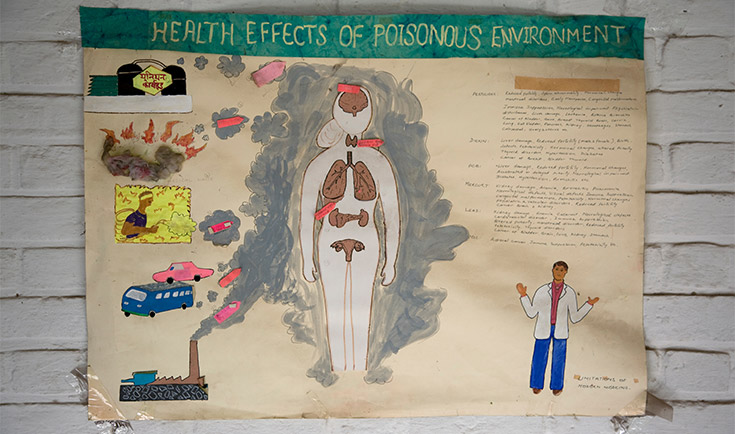Bhopal's ongoing disasters: An update
On the 30th anniversary of the Bhopal Gas Disaster this time last year, Crisis Response Journal told the story of Bhopal’s Twin Disasters, explaining how the abandoned and unremediated Union Carbide pesticide factory, with its thousands of tonnes of highly toxic waste, had inflicted a second, chronic, disaster on the desperate citizens of Bhopal. Now, as the 31st anniversary fell on December 2/3, Colin Toogood reflects on how the situation has developed over the intervening year.

Rajesh,12, has no hair and was born with learning difficulties. His sister, Rashida, protects him from local bullies. They live in an area of the city called Shanka Nagar where the community has to drink contaminated water. Their mother, Yashodabai, is 50 years old and was exposed to MIC gas in 1984. Her husband, Heeralal, died in a fight a few years ago so she has to peel garlic to support her family
(photo: David Graham)
Last year’s report concluded that there were 22 communities acknowledged to be affected by toxically contaminated water, but that they had been provided with at least a rudimentary, piped supply of safe water. However, the reality of the situation was that nobody knew whether the contamination had spread any further and, if it had, how far: “…the unfortunate truth is that nobody knows how far the contamination has spread in to the aquifer and, thus, how many communities are actually affected.”
Enter, at the start of the year, the United Nations Environmental Programme (UNEP) with an offer to perform a complete contamination assessment. Sadly, the Indian Government in a baffling decision, declined UNEP’s offer claiming to have its own site remediation plans.
The state government proposes to dispose of 346 tonnes of toxic waste at a Pithampur-based treatment, storage and disposal facility but the plan is controversial to say the least. Firstly, the waste being referred to is stored above ground and is relatively safely contained but, dotted around the factory site, are numerous unlined pits where vast quantities of dangerous chemical waste remain buried. Furthermore, outside of the factory walls lie the remains of three enormous solar evaporation ponds to which toxic waste was pumped as liquid effluent. Between the unlined pits and the solar evaporation ponds there are literally thousands of tonnes of toxic waste that urgently need removal or treatment.

View of the abandoned Union Carbide factory in Bhopal. The factory still lies derelict some 24 years later (photo: David Graham)
This waste, not discussed in the current plan, is contaminating the groundwater aquifer and a major worry remains that the above ground waste removal might act as a smokescreen in front of the main chemical waste disposal issue. Simply put, the more clean the abandoned site becomes above ground, then the harder it becomes to make the case concerning that which cannot be seen.
The second main problem with the plan is that a serious doubt remains as to whether the plant actually has the technical capability to dispose of the toxic waste in a safe manner and these concerns do not seem to have been answered. If the plant does not treat the waste absolutely effectively then it will spew dioxins all over the surrounding area- and the nearby housing.
As the toxic waste does not look like disappearing anytime soon then what of understanding the actual spread of contamination with UNEP’s offer refused? Earlier this year, scientists from Germany’s ETHECON (Foundation Ethics & Economy) performed a round of both COD (Chemical Oxygen Demand) and Beilstein tests, at the Madhay Pradesh State Research Laboratory, on a range of borewell samples in areas where the water is still being used as a primary supply.
COD is a measure of water quality and is an indirect measurement of organic pollutants. Beilstein tests confirm the presence of organochlorines in water and the those known to exist in groundwater in and around the abandoned factory include dichlorobenzene, trichlorobenzene, benzene hexachloride, hexa chloro cyclo hexane and others.

Twenty-five years after the world’s worst industrial accident the population of Bhopal is trying to cope with a second crisis. Many people are forced to drink and wash in contaminated water resulting in many having contracted serious illnesses and skin problems
(photo: David Graham)
Of 24 samples, 12 of those indicated unsafe COD levels and 11 of those 12 indicated the presence of organochlorines. While this is a frightening enough prospect in itself, the ETEHCON test were, additionally, cleverly contrived to futher the debate so far as the spread of contamination is concerned.
The main hydroegological data for the area has been known to be fundamentally flawed since 2010, when a group of experts, writing on behalf of the combined groups of Bhopal survivors, demonstrated discrepancies between it and the various contamination assessment data available at that time. The group pointed out the presence of contamination in areas not predicted by the existing data and speculated that the problem might, in fact, be even worse than feared with a toxic plume spreading in hitherto unexpected directions and with a greater flow rate.
Sadly, ETHECON’s tests prove exactly that and to a greater degree than most anybody would have reasonably guessed. To refer, once again, to last year’s Crisis Response Journal Report, the fact remains, and seems ever more true, that: “…nobody knows how far the contamination has spread in to the aquifer… They cannot possibly know this until a full contamination survey is finally performed- nor can they know how many people are still being poisoned in Bhopal’s Second Disaster.”

Drawing at the Sambhavna Clinic, which provides free medical treatment to those affected by the gas or suffering from illnesses caused by the contaminated water
Colin Toogood is with the Bhopal Medical Appeal
Colin Toogood, 14/12/2015